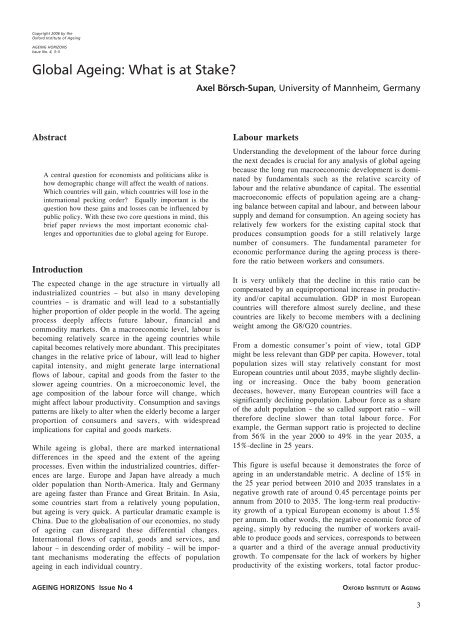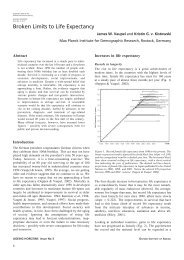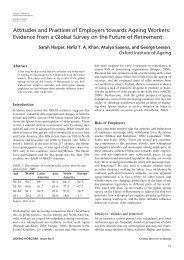Global Ageing: What is at stake? - by Börsch-Supan - Oxford Institute ...
Global Ageing: What is at stake? - by Börsch-Supan - Oxford Institute ...
Global Ageing: What is at stake? - by Börsch-Supan - Oxford Institute ...
You also want an ePaper? Increase the reach of your titles
YUMPU automatically turns print PDFs into web optimized ePapers that Google loves.
Copyright 2006 <strong>by</strong> the<strong>Oxford</strong> <strong>Institute</strong> of <strong>Ageing</strong>AGEING HORIZONSIssue No. 4, 3–5<strong>Global</strong> <strong>Ageing</strong>: <strong>Wh<strong>at</strong></strong> <strong>is</strong> <strong>at</strong> Stake?Axel <strong>Börsch</strong>-<strong>Supan</strong>, University of Mannheim, GermanyAbstractA central question for econom<strong>is</strong>ts and politicians alike <strong>is</strong>how demographic change will affect the wealth of n<strong>at</strong>ions.Which countries will gain, which countries will lose in theintern<strong>at</strong>ional pecking order? Equally important <strong>is</strong> thequestion how these gains and losses can be influenced <strong>by</strong>public policy. With these two core questions in mind, th<strong>is</strong>brief paper reviews the most important economic challengesand opportunities due to global ageing for Europe.IntroductionThe expected change in the age structure in virtually allindustrialized countries – but also in many developingcountries – <strong>is</strong> dram<strong>at</strong>ic and will lead to a substantiallyhigher proportion of older people in the world. The ageingprocess deeply affects future labour, financial andcommodity markets. On a macroeconomic level, labour <strong>is</strong>becoming rel<strong>at</strong>ively scarce in the ageing countries whilecapital becomes rel<strong>at</strong>ively more abundant. Th<strong>is</strong> precipit<strong>at</strong>eschanges in the rel<strong>at</strong>ive price of labour, will lead to highercapital intensity, and might gener<strong>at</strong>e large intern<strong>at</strong>ionalflows of labour, capital and goods from the faster to theslower ageing countries. On a microeconomic level, theage composition of the labour force will change, whichmight affect labour productivity. Consumption and savingsp<strong>at</strong>terns are likely to alter when the elderly become a largerproportion of consumers and savers, with widespreadimplic<strong>at</strong>ions for capital and goods markets.While ageing <strong>is</strong> global, there are marked intern<strong>at</strong>ionaldifferences in the speed and the extent of the ageingprocesses. Even within the industrialized countries, differencesare large. Europe and Japan have already a mucholder popul<strong>at</strong>ion than North-America. Italy and Germanyare ageing faster than France and Gre<strong>at</strong> Britain. In Asia,some countries start from a rel<strong>at</strong>ively young popul<strong>at</strong>ion,but ageing <strong>is</strong> very quick. A particular dram<strong>at</strong>ic example <strong>is</strong>China. Due to the global<strong>is</strong><strong>at</strong>ion of our economies, no studyof ageing can d<strong>is</strong>regard these differential changes.Intern<strong>at</strong>ional flows of capital, goods and services, andlabour – in descending order of mobility – will be importantmechan<strong>is</strong>ms moder<strong>at</strong>ing the effects of popul<strong>at</strong>ionageing in each individual country.Labour marketsUnderstanding the development of the labour force duringthe next decades <strong>is</strong> crucial for any analys<strong>is</strong> of global ageingbecause the long run macroeconomic development <strong>is</strong> domin<strong>at</strong>ed<strong>by</strong> fundamentals such as the rel<strong>at</strong>ive scarcity oflabour and the rel<strong>at</strong>ive abundance of capital. The essentialmacroeconomic effects of popul<strong>at</strong>ion ageing are a changingbalance between capital and labour, and between laboursupply and demand for consumption. An ageing society hasrel<strong>at</strong>ively few workers for the ex<strong>is</strong>ting capital stock th<strong>at</strong>produces consumption goods for a still rel<strong>at</strong>ively largenumber of consumers. The fundamental parameter foreconomic performance during the ageing process <strong>is</strong> thereforethe r<strong>at</strong>io between workers and consumers.It <strong>is</strong> very unlikely th<strong>at</strong> the decline in th<strong>is</strong> r<strong>at</strong>io can becompens<strong>at</strong>ed <strong>by</strong> an equiproportional increase in productivityand/or capital accumul<strong>at</strong>ion. GDP in most Europeancountries will therefore almost surely decline, and thesecountries are likely to become members with a decliningweight among the G8/G20 countries.From a domestic consumer’s point of view, total GDPmight be less relevant than GDP per capita. However, totalpopul<strong>at</strong>ion sizes will stay rel<strong>at</strong>ively constant for mostEuropean countries until about 2035, maybe slightly decliningor increasing. Once the ba<strong>by</strong> boom gener<strong>at</strong>iondeceases, however, many European countries will face asignificantly declining popul<strong>at</strong>ion. Labour force as a shareof the adult popul<strong>at</strong>ion – the so called support r<strong>at</strong>io – willtherefore decline slower than total labour force. Forexample, the German support r<strong>at</strong>io <strong>is</strong> projected to declinefrom 56% in the year 2000 to 49% in the year 2035, a15%-decline in 25 years.Th<strong>is</strong> figure <strong>is</strong> useful because it demonstr<strong>at</strong>es the force ofageing in an understandable metric. A decline of 15% inthe 25 year period between 2010 and 2035 transl<strong>at</strong>es in aneg<strong>at</strong>ive growth r<strong>at</strong>e of around 0.45 percentage points perannum from 2010 to 2035. The long-term real productivitygrowth of a typical European economy <strong>is</strong> about 1.5%per annum. In other words, the neg<strong>at</strong>ive economic force ofageing, simply <strong>by</strong> reducing the number of workers availableto produce goods and services, corresponds to betweena quarter and a third of the average annual productivitygrowth. To compens<strong>at</strong>e for the lack of workers <strong>by</strong> higherproductivity of the ex<strong>is</strong>ting workers, total factor produc-AGEING HORIZONS Issue No 4OXFORD INSTITUTE OF AGEING3
tivity would need increase <strong>by</strong> 40%, probably an unreal<strong>is</strong>ticfigure.The variability range for th<strong>is</strong> forecast <strong>is</strong> large and almostentirely depends on future labour force particip<strong>at</strong>ion of theyoung, the elderly and the female. In most pessim<strong>is</strong>ticscenarios of unchanging labour force particip<strong>at</strong>ion, theimpact of the declining support r<strong>at</strong>io <strong>is</strong> huge. On the otherhand, in an optim<strong>is</strong>tic scenario of Denmark-style labourmarket reforms, the shift in the age structure <strong>is</strong> compens<strong>at</strong>edfor almost entirely <strong>by</strong> the increase in particip<strong>at</strong>ionr<strong>at</strong>es.Th<strong>is</strong> example bears several lessons for policy in times ofglobal ageing. First, the huge variability of the projectionsand the leverage of employment on GDP make clear th<strong>at</strong>it <strong>is</strong> important to better understand how public policy caninfluence labour force particip<strong>at</strong>ion r<strong>at</strong>es. Structuralreforms such as educ<strong>at</strong>ion reform and pension reform havepotentially huge “side-effects” on GDP growth throughtheir impact on employment, over and above the oftenmore prominently d<strong>is</strong>cussed impacts on social budgets.Second, the above example shows how strongly the differentialforce of global ageing depends on to the extent towhich an increasing quality of labour will compens<strong>at</strong>e forthe decreasing quantity of labour. “Side effects” of structuralreforms on productivity may in the long-run domin<strong>at</strong>eany direct but st<strong>at</strong>ic effects, because they change thegrowth p<strong>at</strong>h of the economy.Not only the size but also the age structure of the workingpopul<strong>at</strong>ion will change radically in the coming decades.We again use Germany as an example for how dram<strong>at</strong>icthe change will be. The modal age of the German workforce in the year 2000 was around age 36; in 2010, th<strong>is</strong>peak age will increase to 46 years; and a further 10 yearsl<strong>at</strong>er it will be 54 years. The ba<strong>by</strong> boomers then retire –the age d<strong>is</strong>tribution curve fl<strong>at</strong>tens out and changes verylittle in the following decades.Th<strong>is</strong> fundamental change in the age structure of theworking popul<strong>at</strong>ion will have profound effects on themicroeconomics and the sociology of the labour market.The most important – and most controversial – aspect <strong>is</strong>the potential effect on labour productivity. If labourproductivity <strong>is</strong> age dependent, a shift in the age structurewill also bring about a change in aggreg<strong>at</strong>e productivity,even if age-specific productivity were to remain constant.We know little about the size of these effects. R<strong>at</strong>her, moreresearch on age-specific productivity <strong>is</strong> needed to betterunderstand whether ageing economies will suffer from aproductivity decline, amplifying the effects of a shrinkingquantity of labour. At the very least, however, we understandth<strong>at</strong> further educ<strong>at</strong>ion increases productivity – andherein lies an important policy message: prevent all actionsth<strong>at</strong> make further educ<strong>at</strong>ion less <strong>at</strong>tractive, and strengthenall steps th<strong>at</strong> increase the investment value of further educ<strong>at</strong>ion– such as a l<strong>at</strong>er retirement age.Interactions between labour, product andcapital marketsThe labour market <strong>is</strong> not insul<strong>at</strong>ed from other markets. It<strong>is</strong> not only directly affected <strong>by</strong> popul<strong>at</strong>ion ageing, but alsoindirectly <strong>by</strong> ageing-induced changes in product and capitalmarkets.Product demand will change, since an older popul<strong>at</strong>ion ofconsumers has different preferences and needs than ayounger popul<strong>at</strong>ion. Consumption demand may also declinefor <strong>at</strong> least two reasons. First, because GDP per capita willdecline in the face of a shrinking labour force unless th<strong>is</strong><strong>is</strong> offset <strong>by</strong> higher capital input and productivity. Secondand more subtly, it <strong>is</strong> likely th<strong>at</strong> more retirement incomecomes from asset income which fluctu<strong>at</strong>es more than annuitizedpension and labour income. Th<strong>is</strong> will increaseprecautionary savings and depress consumption, given afixed level of income.Consumption behavior changes with increasing age. Forexample, spending on goods in the group “transport andcommunic<strong>at</strong>ion” falls over the life cycle, while goods inthe “health and hygiene” group, as well as costs of shelter,account for a growing share of older households’ budgets.Hence, if the age d<strong>is</strong>tribution of an economy <strong>is</strong> changing,the composition of consumption will change accordingly.Most notably the aggreg<strong>at</strong>ed expenditure on health willincrease during the ageing process while the correspondingspending on transport will decline.Changing product demand will then precipit<strong>at</strong>e shifts insectoral labour demand. Employment in the health sectorwill increase; it will decline in the transport sector. Someestim<strong>at</strong>es suggest th<strong>at</strong> more than a sixth of all workers willneed to change their jobs due to popul<strong>at</strong>ion ageing.Labour supply <strong>is</strong> also affected <strong>by</strong> capital market fluctu<strong>at</strong>ions.The more retirement income <strong>is</strong> provided throughfunded pension income (e.g., 401k plans or other individualaccounts invested in the stock market), stock marketperformance will, <strong>at</strong> the margin, affect the retirement dec<strong>is</strong>ionof workers as well as their consumption demand.Understanding th<strong>is</strong> mechan<strong>is</strong>m <strong>is</strong> important for analyses ofglobal ageing since it may substantially amplify capitalmarket d<strong>is</strong>turbances. Stock markets have exhibited hugeswings, and we do not fully understand how bubblesemerge and even less how to predict and prevent them.Th<strong>is</strong> topic has a clear political dimension since the flexibilityof choosing the retirement age <strong>is</strong> a core transm<strong>is</strong>sionmechan<strong>is</strong>m for these interactions between the capitalmarket on one side and labour and product markets on theother side.Capital marketsCapital markets play a crucial role in global ageing sincecapital <strong>is</strong> the factor which moves with the least frictionsAGEING HORIZONS Issue No 4OXFORD INSTITUTE OF AGEING4




![ORAL PRESENTATIONS [pdf] - Oxford Institute of Ageing](https://img.yumpu.com/37918222/1/184x260/oral-presentations-pdf-oxford-institute-of-ageing.jpg?quality=85)





